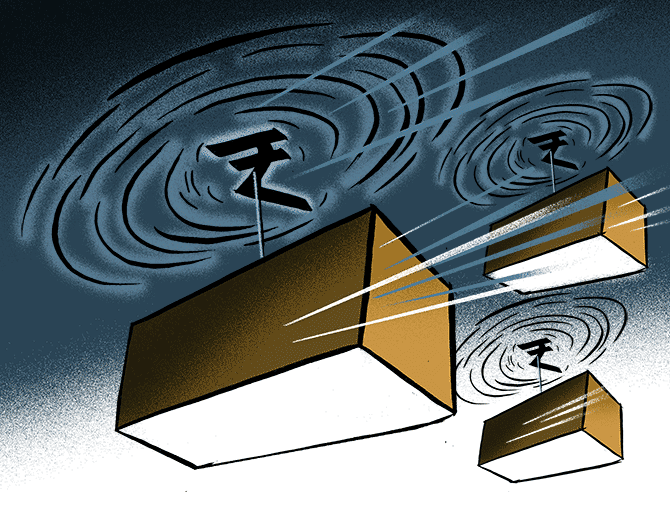 | « Back to article | Print this article |
Experts said a dip in consumption expenditure indicated an increasing prevalence of poverty in the country.
Illustration: Dominic Xavier/Rediff.com

Consumer spending fell for the first time in more than four decades in 2017-18, primarily driven by slackening rural demand, according to the latest consumption expenditure survey by the National Statistical Office (NSO).
The survey - Key Indicators: Household Consumer Expenditure in India - shows the average amount of money spent by a person in a month fell by 3.7 per cent to Rs 1,446 in 2017-18 from Rs 1,501 in 2011-12.
The figures for monthly per capita consumption expenditure (MPCE) are in real terms, meaning these have been adjusted for inflation, keeping 2009-10 as the base year. In 2011-12, the real MPCE had risen 13 per cent over a period of two years.
Experts said a dip in consumption expenditure indicated an increasing prevalence of poverty in the country.
The data set also corroborates a shortage of demand in the economy, driven by the rural market.
In villages, consumer spending declined by 8.8 per cent in 2017-18. In cities, it rose by 2 per cent over six years, according to a copy of the report reviewed by Business Standard.
The survey was conducted by the NSO between July 2017 and June 2018.
The report, which was approved for release by a committee on June 19, 2019, has been withheld by the NSO due to its “adverse” findings, four people aware of the development told this newspaper.
According to the annual report of the Ministry of Statistics and Programme Implementation, the report was supposed to be released in June 2019.
The period in which the survey was conducted coincided with the implementation of the goods and services tax (GST). Also, it came a few months after the government’s demonetisation move.
“In the last five decades at least, there has never been a period that consumption expenditure in real terms has declined.
"This data clearly shows that poverty levels would have gone up substantially.
"A back of the envelope calculation would suggest that the percentage of population in poverty would have gone up by at least 10 percentage points,” Himanshu, associate professor at Jawaharlal Nehru University's Centre for Economic Studies and Planning, said.
Himanshu said the last time the NSO showed a fall in consumption in real terms was in 1972-73 due to a global oil crisis. Before that, in the mid-1960s, consumption fell due to a domestic food crisis.
The most worrying trend in the 2017-18 report, according to experts, is a dip in food consumption for the first time in decades, implying worsening malnutrition in the country.
On average, rural people spent Rs 580 on a monthly basis on food in 2017-18, almost a 10 per cent fall from Rs 643 in 2011-12 (both in real terms). Urban people spent Rs 946 each in 2017-18, compared to Rs 943 in 2011-12, reflecting muted growth.
“It’s a real concern from the point of view of welfare of the people. A fall in food spending, especially in villages, shows that malnutrition has increased.
"It would be fair to say that poverty must have increased significantly,” former Planning Commission Member Abhijit Sen said.
In villages, people cut their expenditure on all food items, except on milk and related products.
In fact, across India, including in cities, people drastically reduced their expenses on essential cooking items such as edible oil, salt, sugar and spices.
The spending on non-food items, such as durable goods, clothing, education, and rent, saw a decline by 7.6 per cent in 2017-18 in rural parts and an increase by 3.8 per cent in urban areas, compared to 2011-12.
Sen said that since there was a time lag of six years between the two data sets produced by the NSO (between 2011-12 and 2017-18), it is unclear when a dip in consumption expenditure might have begun.
Economic commentators and industry watchers have been attributing a falling economic growth to a lack of demand.
India’s gross domestic product (GDP) growth fell to 6.8 per cent in 2018-19 compared to 7.2 per cent in 2017-18 and 6.8 per cent in 2016-17.
In April-June this year, the GDP growth stood at a six-year low of 5 per cent and is likely to be around 4 per cent in the second quarter of this financial year.
In 2017-18, the unemployment rate stood at a 45-year high of 6.1 per cent compared to 2.2 per cent in 2011-12, according to the NSO’s periodic labour force survey which was withheld for release by the government for five months after being approved by the National Statistical Commission (NSC).
The NSO’s consumer expenditure survey was approved by a working group, formed by the NSC, in a meeting five months ago.
Concerned by a falling consumer expenditure being shown by the survey report, the government had formed a sub-committee to look into the data.
According to sources, the sub-committee told the government in a report last month that the survey had no defect.